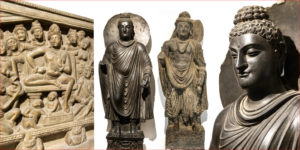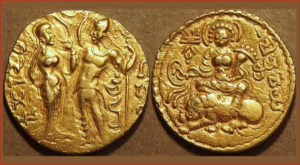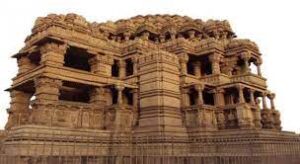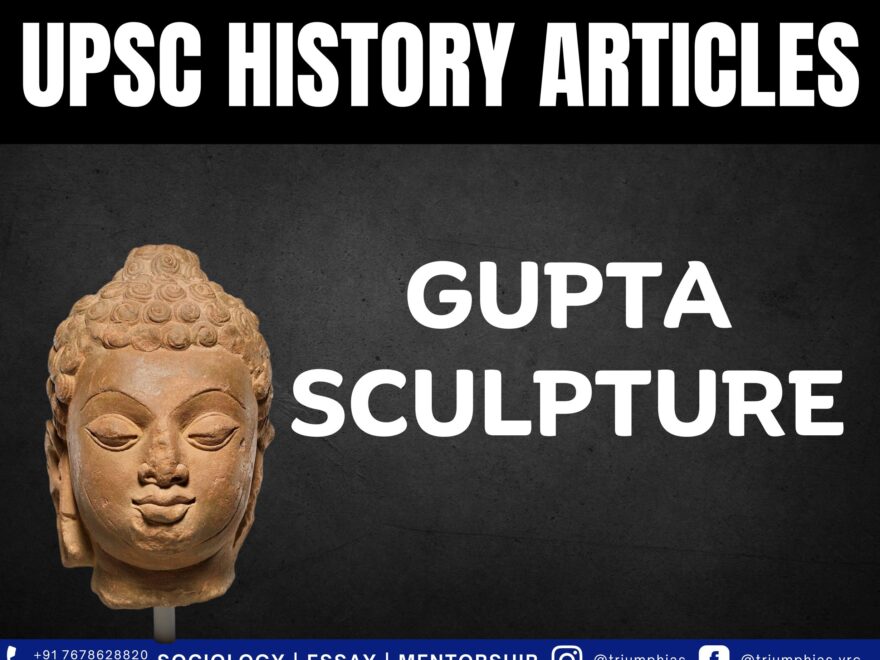Gupta Empire
(Relevant for Historical Section of General Studies Paper Prelims/Mains)

Gupta Sculpture
Geologists suggest that the commencement of the Gupta empire in the 4th century A.D. heralds the dawn of a new era. The rule of the Gupta monarchs persisted until the 6th century in Northern India. During their reign, arts, sciences, and literature thrived significantly. They perfected and standardized the iconographic representations of Brahmanical, Jain, and Buddhist deities, which served as exemplary models of artistic expression not only within India but also beyond its borders. This period witnessed an all-encompassing excellence in domestic life, administration, literature, artistic creations, and religious and philosophical thought, as evident in the works of Kalidasa and the widespread Bhagavata cult, deeply intertwined with an intensive appreciation of beauty.
With the advent of the Gupta era, India entered a phase of classical sculpture. Over centuries, artistic techniques were honed, specific forms were refined, and ideals of beauty were precisely articulated. The period saw an end to experimentation and uncertainty. A clear grasp of art’s genuine objectives and essential principles, along with a well-developed aesthetic sensibility and skilled craftsmanship, yielded remarkable sculptures that became models and inspirations for Indian artists in the future. The Gupta sculptures served as timeless representations of Indian art and influenced artistic ideals even in the Indian colonies located in the Far East.

Gupta Period
During the Gupta period, the trends and inclinations of earlier artistic phases converged into a unified plastic tradition of paramount significance in Indian history. Consequently, Gupta sculpture emerged as a natural progression from the early classical sculptures of Amravati and Mathura. While its plasticity borrowed from Mathura’s style and its grace from Amravati’s, Gupta sculpture seemed to belong to a distinct realm. Gupta artists seemed to be striving for a loftier goal. A novel perspective towards art emerged, one that aimed to forge a closer alignment between artistic expression and intellectual and spiritual insights, inner concepts matching external forms.
Art from Bharhut, Amravati, Sanchi, and Mathura drew closer and coalesced into a unified entity. In compositions, female figures garnered increased attention, while nature receded into the background. However, nature’s continuous and flowing rhythm persisted in the contours of the human form. The human figure, often depicted as an image, became central to Gupta sculpture. A fresh canon of beauty was established, based on a profound understanding of the human body’s innate softness and flexibility.
The supple and yielding bodies of Gupta sculptures, characterized by smooth textures and luminous surfaces, facilitated fluid movement. Even in apparent stillness, these figures exuded an internal energy. This held true not only for depictions of divine beings from Buddhist, Brahmanical, and Jain traditions but also for everyday individuals. The emphasis was on the sensitivity of the sculpted surface, leading to minimal ornamentation, such as drapery and jewellery, to showcase the body.
The prevalence of wet or translucent clinging drapery became a hallmark of this era. However, the sensuous effect of such drapery, particularly in representations of female figures, was balanced by a conscious moral restraint. Nudity, as a rule, was eschewed in Gupta sculpture. The grand artistic achievements of the time displayed graceful contours, understated ornamentation, and dignified tranquillity. Under Gupta patronage, centres like Mathura and Sarnath produced numerous outstanding works. Despite being followers of the Hindu faith, the Guptas were tolerant rulers.
An exquisite example of Gupta craftsmanship is the magnificent red sandstone Buddha image from Mathura, dating back to the 5th century A.D. This image captures the Great Master in his sublime form, standing with his right hand in the abhaya mudra, symbolizing protection, and the left hand holding the garment’s edge. The countenance is serene, with eyes lowered in spiritual ecstasy. The robe draping both shoulders is skill fully rendered, with delicate schematic folds gracefully enveloping the body. The head displays spiral curls with a central prominence, and the ornate halo features concentric bands of elegant decoration.
This mastery of execution and the regal serenity in the Buddha image was embraced and localized by various regions like Siam, Cambodia, Burma, Java, Central Asia, China, and Japan, as these nations adopted the Buddhist faith.
The image of the standing Buddha, found at Sarnath, represents an excellent illustration of mature Gupta artistry. The figure, moulded with softness, stands with its right hand in a protective gesture. In contrast to the intricately carved drapery folds seen in the Mathura Buddha, only the fringes of the diaphanous robe are suggested here. The figure’s flawless execution matches its tranquil spiritual expression, a fitting embodiment of the sublime being.

Sarnath introduced both delicacy and refinement of form, along with a relaxed posture that slightly tilts the standing figure, lending it a litheness and subtle movement. This stands in contrast to the columnar rigidity seen in Mathura works of a similar nature. Even in the case of the seated figure, the slender features exude a sense of motion, with the body echoing the nuanced modeling. Folds of drapery have been largely omitted, with subtle indications surviving as thin lines that suggest the garment’s edges. These loosely falling folds are meticulously rendered with a fabric-like texture. The smooth and shining plasticity of the body takes centre stage in the art of Sarnath.
The zenith of these characteristics culminates in the sublime image of the Master, represented while turning the Wheel of Law. Crafted in Chunar sandstone, the image boasts a surface exuding a smooth shine. Seated in Vijraparyanka, the Master’s hands rest near the chest in Dharmachakrapravartana Mudra.
To master these intricacies and fare well in the Sociology Optional Syllabus, aspiring sociologists might benefit from guidance by the Best Sociology Optional Teacher and participation in the Best Sociology Optional Coaching. These avenues provide comprehensive assistance, ensuring a solid understanding of sociology’s diverse methodologies and techniques.
Gupta Empire, Indian Sculpture, Art History, Gupta Period, Kalidasa, Bhagavata Cult, Mathura, Sarnath, Classical Sculpture, Aesthetic Principles, Iconography, Buddhist Art, Brahmanical Art, Jain Art, Eastern Influence, Chunar Sandstone, Dharmachakrapravartana Mudra, Gupta Empire, Indian Sculpture, Gupta Empire, Indian Sculpture, Best Sociology Optional Coaching, Sociology Optional Syllabus.

Choose The Best Sociology Optional Teacher for IAS Preparation?
At the beginning of the journey for Civil Services Examination preparation, many students face a pivotal decision – selecting their optional subject. Questions such as “which optional subject is the best?” and “which optional subject is the most scoring?” frequently come to mind. Choosing the right optional subject, like choosing the best sociology optional teacher, is a subjective yet vital step that requires a thoughtful decision based on facts. A misstep in this crucial decision can indeed prove disastrous.
Ever since the exam pattern was revamped in 2013, the UPSC has eliminated the need for a second optional subject. Now, candidates have to choose only one optional subject for the UPSC Mains, which has two papers of 250 marks each. One of the compelling choices for many has been the sociology optional. However, it’s strongly advised to decide on your optional subject for mains well ahead of time to get sufficient time to complete the syllabus. After all, most students score similarly in General Studies Papers; it’s the score in the optional subject & essay that contributes significantly to the final selection.
“A sound strategy does not rely solely on the popular
Opinion of toppers or famous YouTubers cum teachers.”
It requires understanding one’s ability, interest, and the relevance of the subject, not just for the exam but also for life in general. Hence, when selecting the best sociology teacher, one must consider the usefulness of sociology optional coaching in General Studies, Essay, and Personality Test.
The choice of the optional subject should be based on objective criteria, such as the nature, scope, and size of the syllabus, uniformity and stability in the question pattern, relevance of the syllabic content in daily life in society, and the availability of study material and guidance. For example, choosing the best sociology optional coaching can ensure access to top-quality study materials and experienced teachers. Always remember, the approach of the UPSC optional subject differs from your academic studies of subjects. Therefore, before settling for sociology optional, you need to analyze the syllabus, previous years’ pattern, subject requirements (be it ideal, visionary, numerical, conceptual theoretical), and your comfort level with the subject.
This decision marks a critical point in your UPSC – CSE journey, potentially determining your success in a career in IAS/Civil Services. Therefore, it’s crucial to choose wisely, whether it’s the optional subject or the best sociology optional teacher. Always base your decision on accurate facts, and never let your emotional biases guide your choices. After all, the search for the best sociology optional coaching is about finding the perfect fit for your unique academic needs and aspirations.
To master these intricacies and fare well in the Sociology Optional Syllabus, aspiring sociologists might benefit from guidance by the Best Sociology Optional Teacher and participation in the Best Sociology Optional Coaching. These avenues provide comprehensive assistance, ensuring a solid understanding of sociology’s diverse methodologies and techniques. Sociology, Social theory, Best Sociology Optional Teacher, Best Sociology Optional Coaching, Sociology Optional Syllabus.
Best Sociology Optional Teacher, Sociology Syllabus, Sociology Optional, Sociology Optional Coaching, Best Sociology Optional Coaching, Best Sociology Teacher, Sociology Course, Sociology Teacher, Sociology Foundation, Sociology Foundation Course, Sociology Optional UPSC, Sociology for IAS,
Follow us :
🔎 https://www.instagram.com/triumphias
🔎https://www.youtube.com/c/TriumphIAS
https://t.me/VikashRanjanSociology
Find More Blogs
|
Scope of the subject and comparison with other social sciences |
|||
|
|
|
|
Modernity and social changes in Europe |

